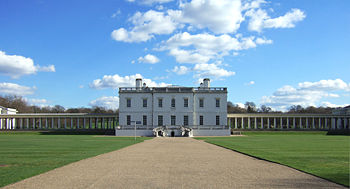User:Russ McGinn/Queen's House, Greenwich: Difference between revisions
imported>Russ McGinn (copying in the lead to work on later - lets get a basic structure fleshed out.) |
imported>Russ McGinn (→References: add reflist) |
||
| Line 40: | Line 40: | ||
</gallery> | </gallery> | ||
==Citations== | |||
{{reflist}} | |||
==References== | ==References== | ||
*http://www.shafe.co.uk/art/early_stuart_12_-_inigo_jones_2.asp | *http://www.shafe.co.uk/art/early_stuart_12_-_inigo_jones_2.asp | ||
*John Bold, Greenwich: ''An Architectural History of the Royal Hospital for Seamen and the Queen's House'' (Yales University Press) 2000, ISBN 978-0300083972 | *John Bold, Greenwich: ''An Architectural History of the Royal Hospital for Seamen and the Queen's House'' (Yales University Press) 2000, ISBN 978-0300083972 | ||
Revision as of 13:55, 18 January 2008
- This article refers to the Queen's House, Greenwich. For the Queen's House, being the alternative name for Buckingham House, see Buckingham Palace
The Queen's House, Greenwich, was designed and begun in 1614-1617 by architect Inigo Jones, early in his architectural career, for Anne of Denmark, the queen of King James I of England. It was altered and completed by Jones, in a second campaign about 1635 for Henrietta Maria, queen of King Charles I.[1] The Queen's House is one of the most important buildings in British architectural history, being the first consciously classical building to have been constructed in Britain. It was Jones's first major commission after returning from his 1613-1615 grand tour[2] of Roman, Renaissance and Palladian architecture in Italy. Some earlier English buildings, such as Longleat, had made borrowings from the classical style; but these were restricted to small details and were not applied in a systematic way. Nor was the form of these buildings informed by an understanding of classical precedents. The Queen's House would have appeared revolutionary to English eyes in its day. Jones is credited with the introduction of Palladianism with the construction of the Queen's House. Although it diverges from the mathematical constraints of Palladio and it is likely that the immediate precedent for the H shaped plan, straddling a road is the Villa Medici at Poggio a Caiano by Giuliano da Sangallo. Today it is both a grade I listed building and a Scheduled ancient monument a status which includes the 115 foot wide, axial vista to the River Thames.
Inigo Jones, the early years
- Basic background
- Masques and the theatre
- First tour of Italy - buys his copy of I Quattro Libri dell'Architettura
- Grand Tour - meeting with Vincenzo Scamozzi and visits most of the works in the Quattro
- Ascent in the ranks
Construction first phase
Fate of Jones and the building during the interregnum
Construction second phase
Greenwich Hospital
19th Century
The Queen's house today
Gallery
Greenwich Hospital from the North, c.1753 by Canaletto
Citations
- ↑ The detailed accounting of the building project is laid out in London County Council, Survey of London, Howard Colvin, ed. The History of The King's Works, Volume IV, 1485-1660, Part II 9) and in John Bold, Greenwich: An Architectural History of the Royal Hospital for Seamen and the Queen's House (Yales University Press) 2000.
- ↑ The phrase 'Grand Tour' was unknown until approximately 1670, but in essence, Jones's tour of Germany, Italy and France, incorporated many of the elements of the later tour.
References
- http://www.shafe.co.uk/art/early_stuart_12_-_inigo_jones_2.asp
- John Bold, Greenwich: An Architectural History of the Royal Hospital for Seamen and the Queen's House (Yales University Press) 2000, ISBN 978-0300083972








